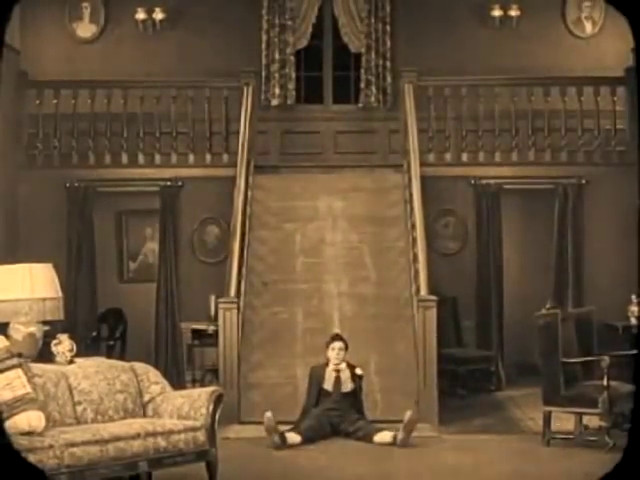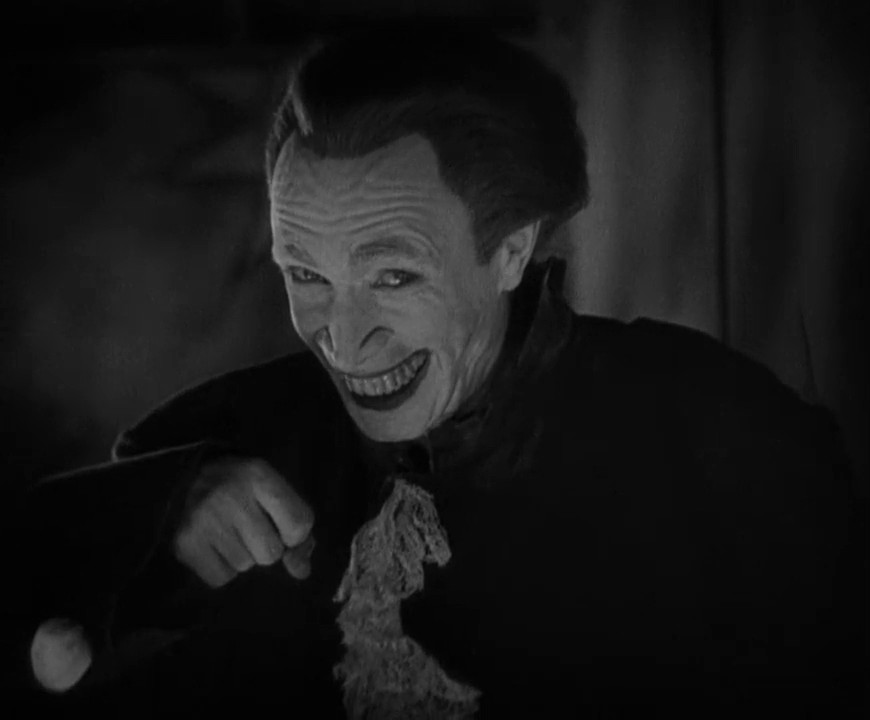Another recurring topic during the Six Weeks of Halloween is Silent Horror films. Most of this sort of thing wouldn’t appeal to a wide audience these days, but for film dorks it can be illuminating to see where many horror tropes originated. Things we think of as modern filmmaking techniques can often be observed in films from a century ago. These two silent horror movies are not the most high-profile examples, but even they cast a long shadow, with influence stretching to the present day.
The Six Weeks of Halloween: Week 2.5 – Silent Horror
- Don’t (fake trailer)
- Monster Problems (short)
- House (trailer)
The Haunted House – Alright, maybe I’m stretching the notion of horror movie by including this Buster Keaton short that isn’t particularly scary. But it does have a haunted house! Sorta! Keaton plays a bank teller who gets mixed up with counterfeiters and bank robbers. Chased by the police, he seeks refuge in a house that is purported to be haunted. Hijinks ensue.
Certainly not top tier Keaton, but there’s some good bits of business going on here. They make extensive use of a staircase that converts to a slide; I can’t imagine this being the first time of such a thing was seen, but from what I can tell, Keaton’s usage set the template that most cinematic examples reference. At minimum he was the trope codifier, especially when it comes to the ending button, which employs the whole stairway to heaven transforming into a slide to hell gag.
Humor is not something that ages particularly well, but I chuckled at a few things here and there, and Keaton’s physical antics are always impressive (I mean, nothing as crazy as his classic train bit in The General, but I enjoyed the glue-related stuff in the bank and there’s a few sequences that prefigure the whole Benny Hill Yakety Sax hallway & doors routine). Slapstick isn’t exactly in fashion these days, but it still works well enough, I guess. Again, not especially horror, but there are some visuals that recall the spooky well enough (I liked the skeleton people). This won’t become an annual seasonal watch (even if it’s a short) and it wouldn’t be the first Keaton I’d recommend, but it purports itself well enough. **1/2
- The Phantom (Robot Chicken)
- Killer Klowns from Outer Space (trailer)
- It (trailer)
The Man Who Laughs – German director Paul Leni’s follow up to The Cat and the Canary came in the leadup to Universal’s string of classic monster movies, but is often lost in the shuffle. After watching it, I can see why. It’s not that the movie is bad, just that it isn’t really horror.
The King of England has a permanent smile carved upon a child’s face in retribution for the father’s treachery (for his part, the father spends some quality time in an Iron Maiden). In the film’s most horrific sequence, the abandoned child makes his way through a hellish winter landscape that is scattered with the hanging skeletons of gypsy traitors. There he rescues another child whose mother had frozen to death. The pair eventually make their way to a philosopher and travelling showman who takes them in. The child’s permanent rictus grin makes him a sideshow star as the Laughing Man, at which point he’s recognized as an heir to an important English family. Therein begins a story of court intrigue that threatens to interrupt the life the Laughing Man was trying to make for himself, including the love of a blind woman (who is thus not repulsed by his scars).
As horror, it’s a definite step backwards from The Cat and the Canary, but Leni’s talent shows through and the story is told well enough. There are some effective side characters, including an unusually influential court jester and a flighty Duchess who views the Laughing Man as a toy to be played with… but the really enduring aspect of this film is the striking appearance of The Laughing Man, played by Conrad Veidt. The unsettling makeup by Jack Pierce rivals other famous visages of the era, especially The Phantom of the Opera, and its clear and lasting influence can be seen in the form of Batman’s most famous foe, the Joker. Indeed, the resemblance is uncanny. Despite the rigidity of the deformed smile, Veidt’s performance is vibrant and expressive, suggesting a wide range of emotions using only his eyes. He’s playing a sad character and that’s quite apparent, even though he’s always got that smile plastered on his face.
Of course, the true hero of the film is Homo, the pet wolf who intervenes on multiple occasions to save our other, lesser protagonists. The name is apparently a play on the latin phrase “Homo homini lupus”, which roughly translates to “Man is wolf to man” (which, given the way people treat one another during the course of the movie, is appropriate.) For the record, Homo is played by a German Shephard credited as “Zimbo”, a worthy companion to Veidt.
It’s not my favorite of the silent films I’ve seen or anything, but it comports itself well and the recent restoration by Universal looks better than most films I’ve seen from the era (even the version on the Internet Archive is in HD). It’s got some of the standard flaws of the silent era. For example, it overemphasizes some of the exposition, which can get tiresome and affect the pacing (it’s a bit longer than it needs to be). There are lots of notes and papers that are shown in full, then each part of the paper is zoomed in upon, then the full shown again, which gets repetitive. Also, you can see that the actors are speaking but you can’t hear what they’re saying! And so on. But I was really taken in by the opening of the movie, which was atmospheric and expressionistic, but as the film proceeds it ventures more into melodrama and court intrigue, which is a bit disappointing given the opening (and its reputation as an early Universal horror flick). But perhaps if I weren’t so focused on genre at the moment, I’d have a better view of it… **1/2
Alright, that’s enough of the highfalutin fancy stuff for this 6WH. It’s time to go more mainstream. Stay tuned for three selections from the CCU on Sunday…


Looks like we were both in the mood for some silent horror this week! I watched The Haunted House last year and it’s pretty cute, as far as these things go. As for The Man Who Laughs, my opinion is very similar to your own. Veidt is great, the make-up is fantastically grotesque, and some of Leni’s visuals in the first act are wonderful. (Also, yes, the dog is named Homo) But otherwise I’ve always found it a bit droll. I think that’s probably why the Joker connection is the first thing most people know about it.
The Joker thing is truly uncanny though. I couldn’t get the association out of my mind while watching. Which makes it a bit weird because seeing the origins of certain things is one of the big draws of silent films for me, so this one being kinda dissonant made it a bit of a strange viewing experience…